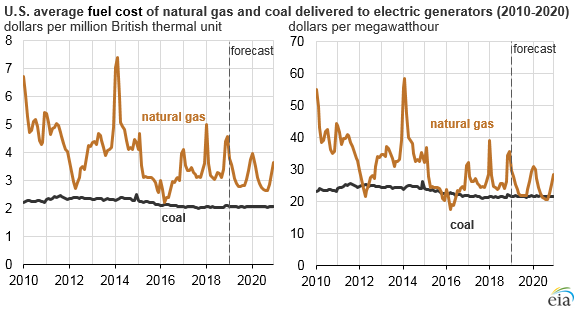The US Energy Information Administration projects that the share of total U.S. electricity generation produced by all renewables other than hydropower will increase by three percentage points during the next two years. BP photo.
Renewables growth due to new generating capacity industry bringing online
By Tyler Hodge
This article was published by the US Energy Information Administration on Jan. 18, 2019.
EIA expects non-hydroelectric renewable energy resources such as solar and wind will be the fastest growing source of U.S. electricity generation for at least the next two years.

Note: Confidence interval derived from NYMEX options market information.
EIA’s January 2019 Short-Term Energy Outlook (STEO) forecasts that electricity generation from utility-scale solar generating units will grow by 10 per cent in 2019 and by 17 per cent in 2020.
According to the January STEO, wind generation will grow by 12 per cent and 14 per cent during the next two years. EIA forecasts total U.S. electricity generation across all fuels will fall by 2 per cent this year and then show very little growth in 2020.
EIA projects that the share of total U.S. electricity generation produced by all renewables other than hydropower will increase by three percentage points during the next two years, from 10 per cent of total generation in 2018 to 13 per cent in 2020.
This projected growth is a result of new generating capacity the industry expects to bring online. About 11 gigawatts (GW) of wind capacity is scheduled to come online in 2019, which would be the largest amount of new wind capacity installed in the United States since 2012.
EIA expects electricity generated from wind this year will surpass hydropower generation. An additional 8 GW of wind capacity is scheduled to come online in 2020. The share of total U.S. generation from wind is projected to increase from 7 per cent in 2018 to 9 per cent in 2020.
Solar is the third-largest renewable energy source in the United States power sector, having surpassed biomass in 2017. The U.S. electric power sector plans to add more than 4 GW of new solar capacity in 2019 and almost 6 GW in 2020, a total increase of 32 per cent from the operational capacity at the end of 2018.
Because of this increase, solar is forecast to contribute slightly more than 2 per cent of total utility-scale generation in 2020.
In addition to utility-scale solar in the electric power sector, some residences and businesses have installed small-scale solar photovoltaic systems to supply some of the electricity they consume.
EIA forecasts that small-scale solar generating capacity will grow by almost 9 GW during the next two years, an increase of 44 per cent.

Even with the growth from renewable energy sources, fossil fuels will still provide most of the electricity generated in the United States. Coal and natural gas combined provided 63 per cent of electricity generation in 2018 and EIA forecasts that they will provide 61 per cent in 2020.
Natural gas fuelled 35 per cent of total U.S. electricity generation in 2018, up from 24 per cent in 2010. In contrast, the share of total generation from coal-fired power plants fell to 28 per cent last year from 45 per cent in 2010.
EIA forecasts the natural gas generation share will grow to 37 per cent by 2020 and coal will continue declining to 24 per cent by 2020.
Coal was the predominant generation fuel in the United States for decades, but in 2016, annual U.S. electricity generation from natural gas-fired power plants surpassed coal-fired generation. Since then, natural gas has remained the primary source of electricity.
In addition to environmental regulations that led to retiring or modifying U.S. coal power plants, the electric power sector’s switch to natural gas from coal has been driven by the sustained low cost of natural gas.
Between 2016 and 2018, the price of natural gas delivered to electricity generators averaged about $3.25 per million British thermal units (MMBtu) compared with $5.09/MMBtu in 2010. Increased overall efficiency of the natural gas power plant fleet has also allowed natural gas to increase its market competitiveness.

Note: Costs in dollars per megawatthour are calculated using average coal and natural gas heat rates as reported in Electric Power Annual Table 8.1.


Be the first to comment